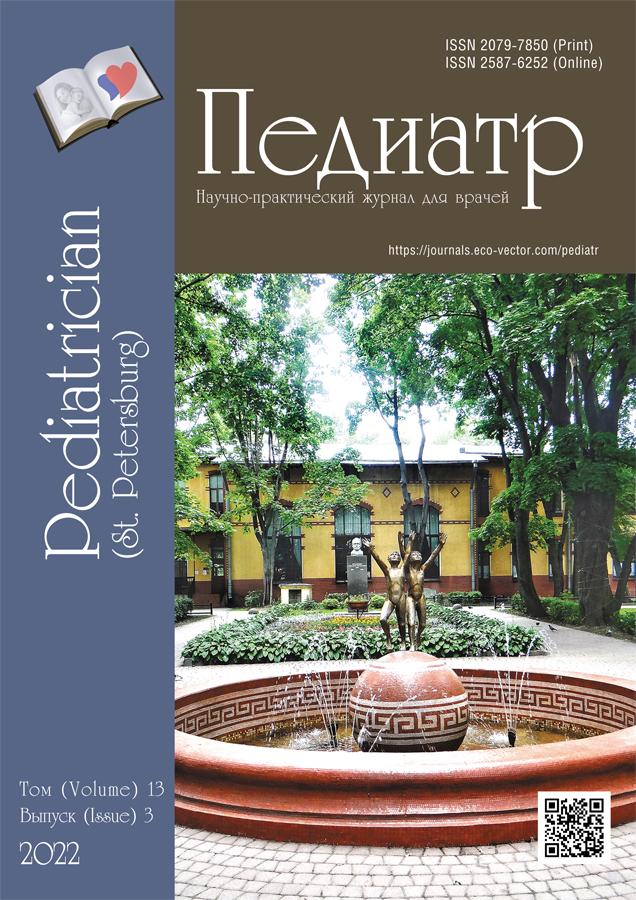Аутоампутация придатков матки вследствие перекрута
- Авторы: Романова Л.А.1, Рухляда Н.Н.1, Тайц А.Н.1, Малышева А.А.1, Дудова К.А.1
-
Учреждения:
- Санкт-Петербургский государственный педиатрический медицинский университет
- Выпуск: Том 13, № 3 (2022)
- Страницы: 65-72
- Раздел: Клинический случай
- URL: https://journals.eco-vector.com/pediatr/article/view/109762
- DOI: https://doi.org/10.17816/PED13365-72
- ID: 109762
Цитировать
Аннотация
Перекрут придатков матки — это неотложное хирургическое состояние, определяемое как полное или частичное вращение яичника и/или фаллопиевой трубы вокруг своей сосудистой оси, вызывающее нарушение кровоснабжения. Постановка диагноза затруднена до операции из-за отсутствия патогномоничных признаков клинической картины и инструментальной диагностики. При перекруте яичник обычно вращается вокруг воронко-тазовой и собственной связок яичника, что вызывает сдавление сосудов, развивается ишемия и некроз, приводя к таким осложнениям, как тромбофлебит тазовых вен, кровотечение, инфицирование, перитонит, а также кальцификация и аутоампутация. Классическая клиническая картина перекрута придатков матки — внезапное начало постоянных/периодических тазовых или абдоминальных болей от умеренных до сильных, диффузных или изолированных с одной стороны. Данное состояние может сопровождаться тошнотой, рвотой, лихорадкой, болезненным и учащенным мочеиспусканием. Наиболее точным инструментальным методом диагностики при перекруте придатков матки является цветное доплеровское ультразвуковое исследование, однако окончательный диагноз ставится только во время операции. Если яичник ишемизирован, рекомендована деторсия придатков, при некротизации выполняют аднексэктомию.
В нашем приведенном клиническом случае у пациентки 38 лет отсутствовали жалобы на момент госпитализации, но в анамнезе — постоянные сильные боли внизу живота на фоне полного благополучия. При ультразвуковом обследовании органов малого таза левый яичник не визуализируется. По данным магнитно-резонансной томографии органов малого таза обнаружено кистозное образование в позадиматочном пространстве с геморрагическим или высокобелковым содержимым, а также отсутствие визуализации левого яичника. При лапароскопии выявлена аутоампутация левых придатков матки вследствие перекрута, наличие некротизированного образования в позадиматочном пространстве. Таким образом, лапароскопия — это единственный достоверный метод диагностики и лечения перекрута придатков матки.
Ключевые слова
Полный текст
Об авторах
Лариса Андреевна Романова
Санкт-Петербургский государственный педиатрический медицинский университет
Email: l_romanova2011@mail.ru
канд. мед. наук, кафедра акушерства и гинекологии
Россия, Санкт-ПетербургНиколай Николаевич Рухляда
Санкт-Петербургский государственный педиатрический медицинский университет
Email: nickolasr@mail.ru
д-р мед. наук, профессор кафедры акушерства и гинекологии
Россия, Санкт-ПетербургАнна Николаевна Тайц
Санкт-Петербургский государственный педиатрический медицинский университет
Email: annataits1@rambler.ru
канд. мед. наук, доцент, заведующая кафедрой акушерства и гинекологии
Россия, Санкт-ПетербургАнна Александровна Малышева
Санкт-Петербургский государственный педиатрический медицинский университет
Email: malisheva.anyuta@yandex.ru
врач гинеколог, отделение гинекологии
Россия, Санкт-ПетербургКристина Андреевна Дудова
Санкт-Петербургский государственный педиатрический медицинский университет
Автор, ответственный за переписку.
Email: dr.kristinaandreevna@gmail.com
ординатор кафедры акушерства и гинекологии
Россия, Санкт-ПетербургСписок литературы
- Боярский К.Ю., Гайдуков С.Н., Чинчаладзе А.С. Факторы, определяющие овариальный резерв женщины // Журнал акушерства и женских болезней. 2009. Т. 58, № 2. С. 65–71.
- Гасымова Д.М., Рухляда Н.Н., Мельникова М.А. Функция единственного яичника после хирургического лечения осложнений доброкачественных опухолей и опухолевидных образований яичников у женщин репродуктивного возраста // Скорая медицинская помощь. 2017. Т. 18, № 1. С. 34–38. doi: 10.24884/2072-6716-2017-18-1-34-38
- Малышева А.А., Абрамова В.Н., Резник В.А., и др. Клинический случай лечения интерстициальной трубной беременности мифепристоном и мизопростолом // Педиатр. 2017. Т. 8, № 6. С. 114–117. doi: 10.17816/PED86114-117
- Рухляда Н.Н., Гасымова Г.М., Новиков Е.И., Мельникова М.А. Оценка овариального резерва в неотложной гинекологии. Учебное пособие. Москва: Стикс, 2014.
- Тайц А.Н., Иванов Д.О., Рухляда Н.Н., Малышева А.А. Опыт диагностики и лечения грудных детей с опухолевыми образованиями яичников // Сборник трудов 2-й Всероссийской научно-практической конференции «Современные проблемы подростковой медицины и репродуктивного здоровья молодежи. Кротинские чтения». Ноябрь 29–30, 2018. Санкт-Петербург. С. 59–66.
- Юрьев В.К. Методология оценки и состояние репродуктивного потенциала девочек и девушек // Проблемы социальной гигиены, здравоохранения и истории медицины. 2000. № 4. С. 3–5.
- Bharathi A., Gowri M. Torsion of the fallopian tube and the haematosalpinx in perimenopausal women — a case report // J Clin Diagn Res. 2013. Vol. 7, No. 4. P. 731–733. doi: 10.7860/JCDR/2013/5099.2896
- Khaitov D., Gabbur N. Contralateral recurrence of fallopian tube torsion: A case report // Case Rep Womens Health. 2021. Vol. 30. ID e00307. doi: 10.1016/j.crwh.2021.e00307
- Konoplitskyi V.S., Korobko Yu.Ye. Assessment of the influence of uterine appendages torsion on their pathomorphological changes in the experiment // Wiadomości Lekarskie. 2021. Vol. 74, No. 8. P. 1876–1884. doi: 10.36740/WLek202108117
- Lee K.H., Song M.J., Jung I.C., et al. Autoamputation of an ovarian mature cystic teratoma: a case report and a review of the literature // World J Surg Oncol. 2016. Vol. 14. ID217. doi: 10.1186/s12957-016-0981-7
- Malhotra V., Dahiya K., Nanda S., Malhotra N. Isolated torsion of the fallopian tube in a perimenopausal woman: A rare entity // J Gynecol Surg. 2012. Vol. 28, No. 1. P. 31–33. doi: 10.1089/gyn.2011.0020
- Laufer M.R., Sharp H.T., Levine D., Chakrabarti A. Ovarian and fallopian tube torsion // UpToDate.
- Rizk D.E., Lakshminarasimha B., Joshi S. Torsion of the fallopian tube in an adolescent female: a case report // J Pediatr Adolesc Gynecol. 2002. Vol. 15, No. 3. P. 159–161. doi: 10.1016/s1083-3188(02)00149-3
- Sankaran S., Shahid A., Odejinmi F. Autoamputation of the fallopian tube after chronic adnexal torsion // J Minim Invasive Gynecol. 2009. Vol. 16, No. 2. P. 219–221. doi: 10.1016/j.jmig.2008.11.014
- Spinelli C., Piscioneri J., Strambi S. Adnexal torsion in adolescents // Curr Opin Obstet Gynecol. 2015. Vol. 27, No. 5. P. 320–325. doi: 10.1097/GCO.0000000000000197
- van der Zanden M., Nap A., van Kints M. Isolated torsion of the fallopian tube: a case report and review of the literature // Eur J Pediatr. 2011. Vol. 170. P. 1329–1332. doi: 10.1007/s00431-011-1484-8
Дополнительные файлы













